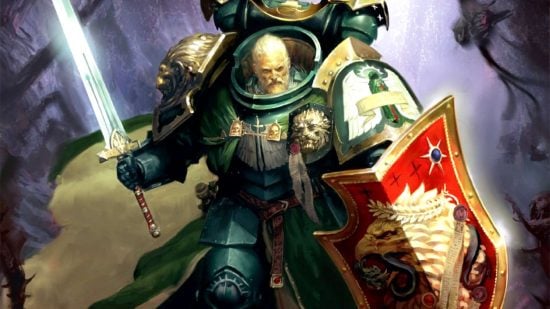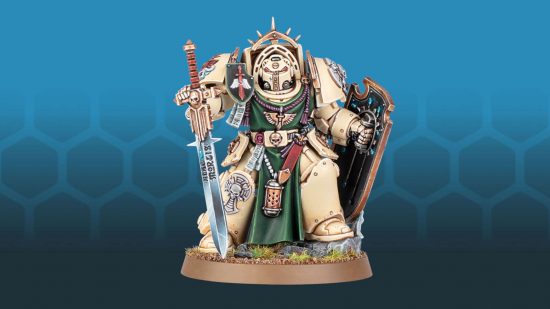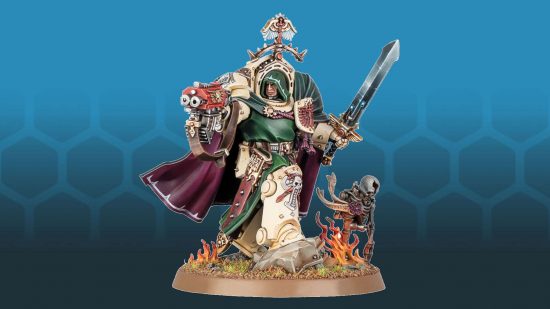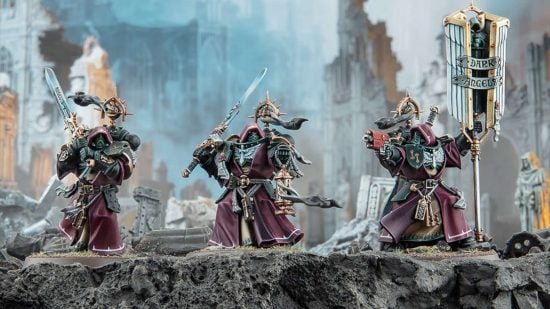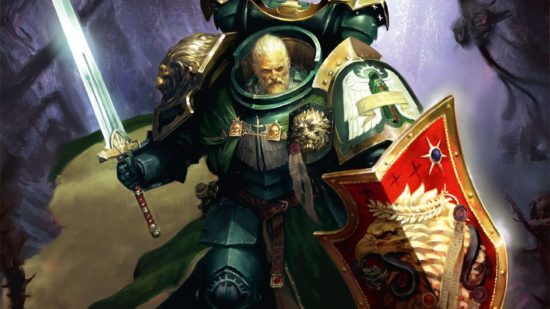Our Verdict
With thematic ways to build your force, and a smart evolution of long-established lore, this Codex should please new and old Dark Angels collectors - though a few absent units and unbalanced upgrades keep it from true greatness.
- A great entry point to the Dark Angels' lore
- New Detachments are fun and thematic
- Gorgeous color section with great model photographs
- Some upgrades are so good, they're probably auto-includes
- Some classic models don't have rules any more
The core of the Dark Angels’ identity is “secrets and lies” – secrets and lies that writers have spent almost thirty years alternately embellishing and then exposing. The latest Codex Dark Angels recaps those riddles ingeniously, adds to them, and even conveys key themes of subterfuge and bloody-minded determination via new army rules.
As per our full faction guide on the Dark Angels, they are among the most mysterious Warhammer 40k factions – not to the fans, of course, we know exactly what’s going on – but to the rest of the Imperium of Man. Dark secrets, unforgivable sins, and terrible regrets have been key themes for the Chapter since their first proper write up in 1996, in the 2nd edition Warhammer 40k Codex ‘Angels of Death’.
Much of the Dark Angels mystique is bound up in the tragic feud between their primarch Lion El’Jonson and his adoptive father Luther. Codex: Angels of Death introduced some of the earliest Horus Heresy lore to the Warhammer 40k universe, telling of Luther’s fall to Chaos, and the battle between the two former allies that resulted in the destruction of the Dark Angels’ homeworld Caliban.

The Dark Angels have spent the ten millennia since that event – and the 27 years real-world years since Angels of Death was published – hunting down the Fallen, those traitorous Dark Angels who sided with Luther and survived the catastrophic destruction of Caliban. The Lion, meanwhile, spent that time in a King Arthur-style torpor, lost to his warriors but destined to return to save them in their darkest hour.
The challenge for every new Dark Angels Codex is to introduce all of that gloom and skullduggery in a way that’s comprehensible for new players, doesn’t contradict or undercut what’s come before, and some as fresh and mysterious as it was 27 years ago.
This latest Codex also has to account for the events of the Arks of Omen narrative expansions, and Mike Brooks’ Warhammer 40k book The Lion: Son of the Forest, which brings the Lion back to consciousness in the 41st millennium, ready to kick some daemon ass.
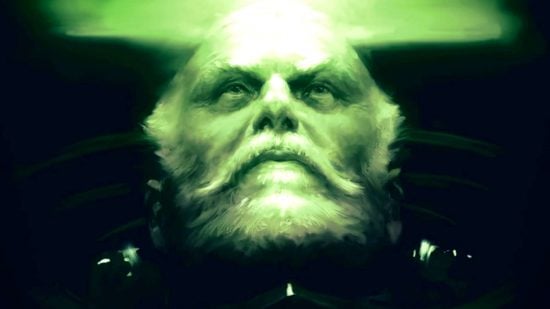
The return of the Lion is a particularly tricky piece of lore to communicate – what effect has he had on the Unforgiven? Too much change to the gloomy brotherhood risks dispelling the pall of secrecy that characterises the Dark Angels; too little change would make a momentous event feel weightless. I think the 10th edition Codex gets it right.
The Lion was always a semi-mythical figure, and his warp-touched return has not diminished that. He’s now able to ‘forest-walk’, slipping through an ethereal echo of the forests of lost Caliban to cross vast distances in moments. He fights as the Knight of Nihilus, appearing where he’s needed most in the Chaos-wracked wilds of the Imperium.
He’s having an influence on the Dark Angels’ fortress monastery, too; echoes of the otherworldly forest are creeping into his labyrinthine secret chambers in the depths of The Rock, and the enigmatic Watchers in the Dark are becoming more numerous. And while the Lion has taken to intervening in some of the ruthless torture of the Fallen conducted by the Interrogator Chaplains, none in the Chapter know quite what he does with these lost warriors – they simply vanish.
Codex Dark Angels detachments
The rules section adds two new Dark Angels 40k Detachments, one for each of the Dark Angels’ specialised companies: the Inner Circle Task Force for the Deathwing, and the Company of Hunters for the Ravenwing. The Unforgiven Task Force returns from the Dark Angels Index almost entirely unchanged, bar a minor tweak to the ‘Unbreakable Lines’ stratagem.
The Inner Circle Task Force buffs your Deathwing Models – a broad selection, including every Space Marine Terminator, every tank big enough to transport them, dreadnoughts, and other veterans. Deathwing Infantry gain a bonus to wound enemies within range of a Vowed objective that you’ll choose each round – similar to how the Adeptus Mechanicus Explorator force works.
I’ll call out the ‘Deathwing Assault’ enhancement as an auto-take here: it allows a Deathwing model capable of deep striking, and the unit it’s leading, to arrive on turn one irrespective of mission rules. Deathwing Knights units are now limited to five models maximum, so expect 11 man blobs of regular Deathwing Terminators led by a Captain or Librarian to teleport onto the board on the first game turn, regularly.
Likewise, the ‘Relic Teleportarium’ stratagem – which costs just one CP – is going to see a lot of play. It allows a unit to teleport anywhere at least 3” from an enemy unit. While the unit is prevented from charging in the same turn – a significant downside – it will make it tough for enemies to screen you off objectives unless they can fully encircle them.
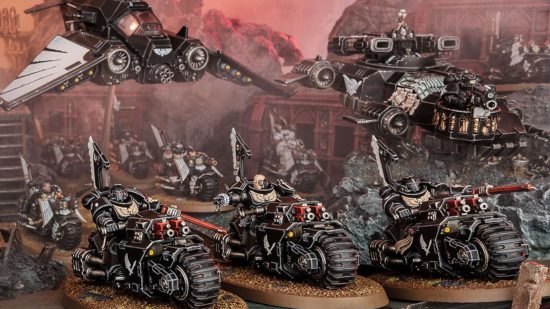
Company of Hunters gives all Outrider units the Battleline keyword, letting you max out your bikers if that’s what you want to do. While the enhancements and Stratagems in this Detachment only affect Ravenwing units (a courtesy extended to anything on a bike and anything in the air), its army rule allows any of your units to shoot in the same turn that they Advanced or Fell Back – so you can splash a Gladiator or some Centurions in the list and they’ll get to play too.
Unsurprisingly, this Detachment is focused on maneuver warfare. The ‘Master of Manoeuvre’ enhancement lets you set up a unit in Strategic Reserves without it counting towards the Strategic Reserves points limit, and allows it to enter the battle as though the round number was one higher than it is – enabling a flanking attack on turn one, or an assault from your opponent’s backline on turn two, is an option.
It’s a powerful enhancement, though you’re limited in the units that can equip it – a Chaplain on Bike, or a Ravenwing Command Squad. The Command Squad is a little more flexible than it was before – it can now be attached to a unit of Ravenwing Black Knights or Outriders. Expect a massed cavalry flank attack to be a big part of the Ravenwing game plan.
It’s all right on theme for the Ravenwing, with stratagems like ‘The Hunters’ Trail’ which lets your bikers retain control of an objective even after you make tracks away from it, or ‘Rapid Reappraisal’, which scoops a unit off the battlefield and back into Strategic Reserves.
Codex Dark Angels units
There’s only one new unit in Codex Dark Angels; The Inner Circle Companions are an elite melee infantry unit somewhat similar to Bladeguard Veterans. They’re oriented a little bit more around offense than defense. In place of the Bladeguard Veterans’ invulnerable saves, enemies suffer a -1 penalty to hit them while the unit is led by a character.
The Companions’ Calibanite Great Blades have more strength, but less AP, than the Bladeguard’s Master-Crafted Power Swords, but have a choice of attack profiles with useful weapon abilities: one with Lethal Hits, for punishing vehicles and monsters, another with Sustained Hits 2 for threshing through infantry hordes. They also hate enemy characters, and get a +1 bonus to hit them.
Any character that can lead a unit of Sternguard Veterans can lead the Companions, which means more or less any character in Tacticus Armor without a storm shield. Attach them to Asmodai for re-rolls to hit in melee, or Ezekiel for extra melee attacks, and watch them blend.
The Codex brings some nips and tucks to existing unit profiles. The Lion’s ‘Shield of the Emperor’ no longer inflicts a -1 to Wound penalty on enemy attacks, but the Primarch is still a veritable wood chipper in melee combat; since crossing the Rubicon Primaris, Asmodai has gained some extra melee hitting power; Belial is now a lot less likely to inflict retributive mortal wounds when he gets hit in melee; and so on.
Unless there was something wrong with the PDF we received from Games Workshop, the Ravenwing Talonmaster – a character in a Land Speeder – has gone. Unsurprising, as the classic Land Speeder kit has gone to the big recycling bin in the sky, but sad for long-term Ravenwing collectors.
The Deathwing Strikemaster and Deathwing Command squad have also been sent to a farm upstate. This feels like a shame; the updated Deathwing Terminator models are absolutely fantastic, and it would have been brilliant to see things like the Company Champion’s Halberd of Caliban rendered in the updated model style.

Overall judgment
The new Codex does a great job communicating the Dark Angels’ flavor, both in the Chapter history and lore, and in the new Detachments. If you want to lean into a Deathwing force, you’re incentivised to slam your elite infantry onto contested objectives and dare your opponent to take them back; Ravenwing forces will be as maneuvrable and difficult to pin down as Eldar.
Every enhancement and Stratagem in the new Detachments looks usable, but the two that I highlighted above are good enough that they’re probably auto-takes. Being able to enter the battlefield from reserve on turn one is so powerful that it’s forbidden under normal matched play mission rules, so paying 30 points for the privileged seems like a no-brainer.
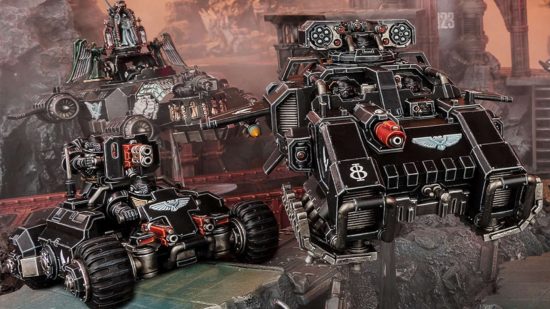
There are enough changes to datasheets that existing players will need to read through everything before their first game, but every unit has the same role and most of the same stats in the Codex as it did in the Index.
The single new unit, the Inner Circle Companions, doesn’t feel like it fills a substantially different role to Bladeguard Veterans, but the stats match up to their impressive new models – and who doesn’t want more elite melee infantry?
Despite gaining a unit, the Dark Angels’ army list has shrunk. The excellent new models for Terminator-clad Captains and Librarians should soften the blow for Deathwing collectors, but Ravenwing players may feel salty at the loss of the Talonmaster, particularly when their signature models haven’t had the same glow up that the Terminators have.
New players should find this Codex a good introduction to the mysteries of the Unforgiven; those of you already in the Inner Circle have yet more secrets to uncover.
